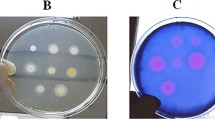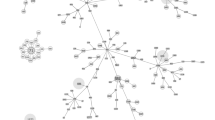Abstract
Twenty-six coagulase-negative staphylococci isolated from patients with various foreign body infections were characterised using different typing systems.Staphylococcus epidermidis was the most predominant species found. Phage typability was below 50 % in all strains. The strains showed differences in surface properties — relative hydrophobicity or hydrophilicity — and ability to adhere to polystyrene with subsequent slime production (adherence tube test). Protein and polypeptide profiles as well as plasmid profiles demonstrated the heterogeneity of the strains. Thus, this preliminary study indicates that all coagulase-negative staphylococci of human origin may become involved in foreign body infections.
Similar content being viewed by others
References
Peters, G., Locci, R., Pulverer, G. Microbial colonization of prosthetic devices. II: Scanning electron microscopy of naturally infected intravenous catheters. Zentralblatt für Bakteriologie, Mikrobiologie und Hygiene (B) 1981, 713: 293–299.
Christensen, G. D., Simpson, W. A., Bisno, A. L., Beachey, E. H. Adherence of slime-producing strains ofStaphylococcus epidermidis to smooth surfaces. Infection and Immunitiy 1982, 37: 318–326.
Hogt, A. H., Dankert, J., De Vries, J. A., Feijen, J. Adhesion of coagulase-negative staphylococci to biomaterials. Journal of General Microbiology 1983, 129: 2959–2968.
Bayston, R., Penny, S. R. Excessive production of mucoid substance inStaphylococcus S II A, a possible factor in colonization of Holter Shunts. Developmental Medicine and Child Neurology 1972, 14, Supplement 27: 25–28.
Peters, G., Locci, R., Pulverer, G. Adherence and growth of coagulase-negative staphylococci on surfaces of intravenous catheters. Journal of Infectious Diseases 1982, 146: 479–482.
Gray, E. D., Peters, G., Verstegen, N., Regelmann, W. E. Effect of extracellular slime substance fromStaphylococcus epidermidis on the cellular immune response. Lancet 1984, i: 365–367.
Johnson, G. M., Lee, D. A., Regelmann, W. E., Gray, E. D., Peters, G., Quie, P. Interference with granulocyte function byStaphylococcus epidermidis slime. Infection and Immunity 1986, 54: 13–20.
Peters, G., Schumacher-Perdreau, F., Jansen, B., Bey, M., Pulverer, G. Biology ofStaphylococcus epidermidis extracellular slime. In: Pulverer, G., Quie, P. G., Peters, G. (ed.): Pathogenicity and clinical significance of coagulase-negative staphylococci. G. Fischer Verlag, Stuttgart, 1987, p. 15–31.
Ludwicka, A., Uhlenbruck, G., Peters, G., Seng, P. N., Gray, E. D., Jeljaszewicz, J., Pulverer, G. Investigation on extracellular slime produced byStaphylococcus epidermidis. Zentralblatt für Bakteriologie, Mikrobiologie und Hygiene (A) 1984, 258: 256–267.
Kloos, W. E., Schleifer, K. H. Simplified scheme for routine identification of humanStaphylococcus species. Journal of Clinical Microbiology 1975, 1: 82–88.
Pulverer, G., Pillich, J., Haklová, M. Phage typing set for the speciesStaphylococcus albus. In: Jeljaszewicz, J. (ed.): Staphylococci and staphylococcal diseases. G. Fischer Verlag, Stuttgart, 1975, p. 153–157.
Rosenberg, M., Gutnick, D., Rosenberg, E. Adherence of bacteria to hydrocarbons: a simple method for measuring cell surface hydrophobicity. FEMS Microbiology Letters 1980, 9: 29–33.
Schumacher-Perdreau, F., Rotering, H., Pulverer, G. Cell wall analysis and taxonomy of staphylococci. Zentralblatt für Bakteriologie, Mikrobiologie und Hygiene (A) 1983, 256: 25–36.
Van de Rijn, I., Kessler, R. E. Growth characteristics of group A Streptococci in a New Chemically defined medium. Infection and Immunity 1980, 27: 444–448.
Naidoo, J., Noble, W. C. Skin as a source of transferable antibiotic resistance in coagulase-negative staphylococci. In: Pulverer, G., Quie, P. G., Peters, G. (eds.): Pathogenicity and clinical significance of coagulase-negative staphylococci. G. Fischer Verlag, Stuttgart, 1987, p. 225–232.
Meyers, J. A., Sanchez, D., Ellwell, L. P., Falkow, S. Simple agarose gel electrophoretic method for the identification and characterization of plasmid deoxyribonucleic acid. Journal of Bacteriology 1976, 127: 1529–1537.
Peters, G. Adherence ofStaphylococcus epidermidis to plastic devices. In: Gemmel, C. G. (ed.): Coagulase-negative staphylococci. Journal of Medical Microbiology 1986, 22: 285–295.
Parisi, J. T., Hecht, D. W. Plasmid profiles in epidemiologic studies of infections byStaphylococcus epidermidis. Journal of Infectious Diseases 1980, 141: 637–643.
Archer, G. L., Karchmer, A. W., Wishniavsky, N., Johnston, J. L. Plasmid-pattern analysis for the differentiation of infecting from noninfectingStaphylococcus epidermidis. Journal of Infectious Diseases 1984, 149: 913–920.
Author information
Authors and Affiliations
Rights and permissions
About this article
Cite this article
Schumacher-Perdreau, F., Jansen, B., Peters, G. et al. Typing of coagulase-negative staphylococci isolated from foreign body infections. Eur. J. Clin. Microbiol. Infect. Dis. 7, 270–273 (1988). https://doi.org/10.1007/BF01963100
Issue Date:
DOI: https://doi.org/10.1007/BF01963100




